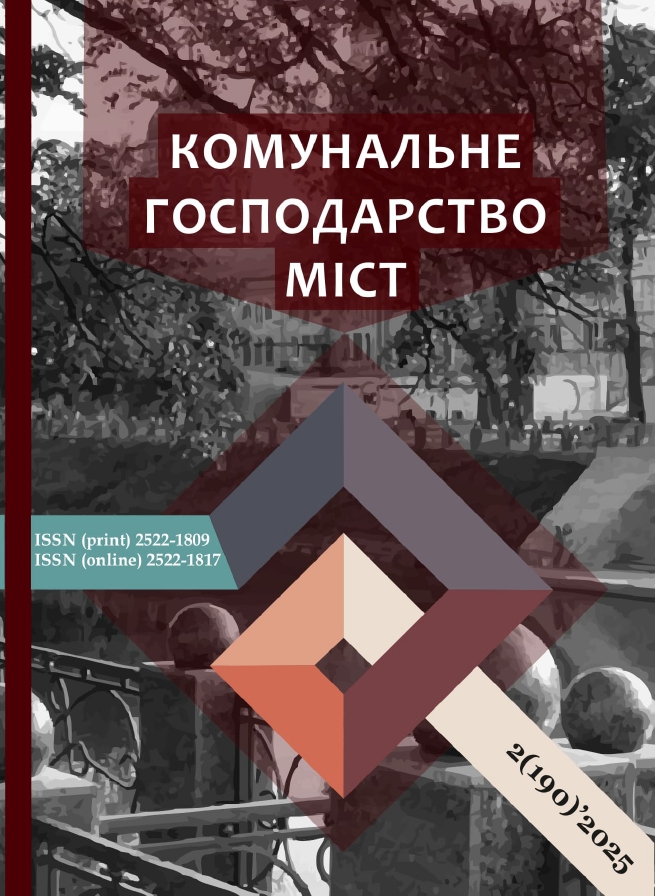MECHANISM FOR IMPLEMENTING PUBLIC-PRIVATE PARTNERSHIP IN WATER SUPPLY AND SEWERAGE ENTERPRISES
DOI:
https://doi.org/10.33042/2522-1809-2025-2-190-15-21Keywords:
Public-Private Partnership, Water Supply, Sewerage Sector, Infrastructure Development, Investment MechanismsAbstract
The article explores the mechanism for implementing Public-Private Partnership (PPP) in the water supply and sewerage sector in Ukraine. Reliable and uninterrupted water supply and sewerage services are critical components of any country’s infrastructure. However, Ukraine faces significant challenges in this sector, including outdated infrastructure, high operational costs, and insufficient investment. The study highlights the urgent need for modernization and identifies PPP as a key instrument for attracting private investments and innovative technologies to improve infrastructure efficiency.
The article begins by analyzing the current state of Ukraine's water supply and sewerage sector, emphasizing the deterioration of infrastructure and financial constraints. Many water supply and sewerage systems in Ukraine have been in operation for over 50 years, leading to frequent failures, water losses, and environmental pollution. The war-related destruction has further exacerbated these issues, particularly in the eastern and southern regions, where damage to water supply networks and pumping stations has resulted in water shortages and deteriorating service quality.
The study examines various PPP models, including concessions, joint ventures, and public-private contracts. The research underscores the importance of a strong legal framework and effective risk distribution between the state and private sector to ensure successful PPP implementation. Financial incentives, state guarantees, and tariff stability are identified as critical factors in attracting private investment.
The article also addresses the challenges facing PPP implementation in Ukraine, including political instability, inadequate legal regulations, and public distrust toward private investments in strategic sectors. The study proposes specific measures to improve the PPP mechanism, such as simplifying contract procedures, introducing state guarantees for investment protection, and enhancing public oversight and transparency.
International experience, particularly from France and the UK, demonstrates that well-structured PPP models can reduce state expenses and increase infrastructure efficiency. The research suggests that adopting these models in Ukraine, with necessary adaptations to local conditions, could significantly improve water supply and sewerage services. The findings highlight the need for comprehensive regulatory reforms and financial incentives to enhance the attractiveness of PPP projects for private investors.
The article concludes that PPP offers a viable solution for modernizing Ukraine’s water infrastructure and ensuring sustainable service delivery. Further research should focus on evaluating the performance of implemented PPP projects and refining the legal and financial mechanisms to maximize their effectiveness.
References
Козаченко М. О. Теоретичні засади державно-приватного партнерства в Україні. — Наукова думка, Київ, 2023. — С. 45-59.
Зозуля І. В. Державно-приватне партнерство: принципи та моделі. — Економіка України, Київ, 2021, № 5. — С. 112-125.
Український інститут водних ресурсів.. Проблеми водопостачання в Україні та шляхи їх вирішення. — Київ: УІВР, 2023. — С. 34-48.
Міністерство розвитку громад та територій України. Звіт про стан водопостачання та водовідведення в Україні. — Офіційний сайт Міністерства розвитку громад та територій України. www.minregion.gov.ua (дата звернення: 03.03.2025).
Михайлов А. В.. Механізми державно-приватного партнерства в інфраструктурних проектах. — Журнал інфраструктурних досліджень, Харків, 2022, № 4. — С. 78-85.
Міністерство водних ресурсів Франції. Досвід реалізації концесій у водопостачанні. — Французький журнал водних ресурсів, Париж, 2022, № 2. — С. 102-113. — www.water.gov.fr (дата звернення: 03.03.2025).
World Bank. India Water Concessions: Lessons and Insights. — World Bank Reports. Вашингтон, 2021. — www.worldbank.org.
Хоменко О. П.. Виклики для державно-приватного партнерства в Україні. — Журнал економічних реформ, Київ, 2024, № 1. — С. 56-64.
European Commission. Guidelines for Public-Private Partnerships. Brussels: EU Publications, 2020. – 112 p.
Hodge, G., & Greve, C. (2019). The PPP Phenomenon: Performance and Governance Insights. Public Administration Review, 79(4), 545-552.
OECD. Public-Private Partnerships in the Water Sector. Paris: OECD Publishing, 2021. – pp. 112-134.
Hall, D. (2020). Water Privatisation and Public-Private Partnerships: Global Lessons. Utilities Policy, 62, 101-114.
Downloads
Published
How to Cite
Issue
Section
License
The authors who publish in this collection agree with the following terms:
• The authors reserve the right to authorship of their work and give the magazine the right to first publish this work under the terms of license CC BY-NC-ND 4.0 (with the Designation of Authorship - Non-Commercial - Without Derivatives 4.0 International), which allows others to freely distribute the published work with a mandatory reference to the authors of the original work and the first publication of the work in this magazine.
• Authors have the right to make independent extra-exclusive work agreements in the form in which they were published by this magazine (for example, posting work in an electronic repository of an institution or publishing as part of a monograph), provided that the link to the first publication of the work in this journal is maintained. .
• Journal policy allows and encourages the publication of manuscripts on the Internet (for example, in institutions' repositories or on personal websites), both before the publication of this manuscript and during its editorial work, as it contributes to the emergence of productive scientific discussion and positively affects the efficiency and dynamics of the citation of the published work (see The Effect of Open Access).

